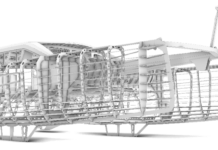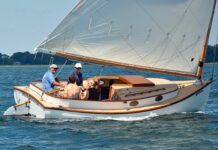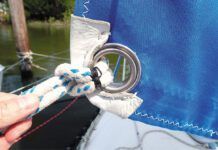Spartite Alternative
Your July 15 issue gives attention to mast collars. On a Tartan 34 where every year involves winter lay-up with the mast out, I’ve had good results with the following treatment:
1. In place of wood chocks, cut a piece of sheet rubber 1/2″ thick, 4-5″ wide, and long enough to encircle the mast. The 1/2″ thickness seems to be a nice fit. Secure the rubber piece in place by using an oversized hose clamp. Rubber allows breathing.
2. Using a 5″ Ace bandage, make a nice-looking boot wrapping around the mast with at least two layers. Fasten in place using sail twine, and then coat the wrapping with “plastic dip,” available from hardware stores. The dip comes in a number of colors?I use white and dab it on until the surface is free of air holes. It can be completed in one sitting.
During sailing season there are absolutely no leaks. At lay-up time just cut it all away.
-Jakob Isbrandtsen
East Norwalk, CT
———-
Lifesling: Need Both Parts
We have been cruising Puget Sound in Washington for over 27 years. Since 1990 we have had Lifesling on our boats. However, it was only in 1996 that we finally took a Lifesling class. What an eye-opener!
The all-day class was given by a local sailing association for a nominal cost per participant. Because we volunteered the use of our boat, the fee was waived. In the morning, films and testimonials preceded the learning of the sequence needed to effect a successful rescue. Afternoon was to be dedicated to on-board practice.
We learned in the morning that we were missing the critical hoisting gear. No, we had never practiced, but we had discussed how we should use the main halyard and the winch to pull the victim over the transom. There was a chilling testimonial from a member of the association whose wife had been able to get him to the boat, but couldn’t get him on board. Puget Sound is cold enough so that he was no help after the first 10 minutes, and if there hadn?t been a couple of skippers on nearby boats to help, she might have lost him to hypothermia. He was still limping a year and a half later!
At the time we bought our first two Lifeslings, the hoisting gear was only mentioned in the instructions. Now, at least, a separate block and tackle- rigged line is being marketed right next to the Lifesling. The ratio is at least 5:1; more is always better. Fortunately, the instructors for the course had brought their own.
During the afternoon session we used a live 200+ lb. pound diver (in a drysuit so he could stand being in the frigid water) who obligingly fell overboard for each person at the helm. That same person was required to complete the entire rescue process alone. We learned that our boat could turn continuously in circles without switching the headsail from side to side, and that neatness didn’t count when stopping the boat and dropping the main. What was important was getting the victim to the boat and rigging the hoisting gear so he could be lifted over the lifelines. And he was, twice per student.
Our advice is to take a course when it is offered in your area, volunteer your own boat if possible, and see for yourself how simple and efficient the Lifesling can be, if you have both parts. In our area both the Seattle Women’s Sailing Association and the Milltown Racing Association in Everett give classes every year. If you can’t find one in your area, see if you can get one going through a local organization. Then you’ll be ready to use the Lifesling, even if it’s never needed.
-Sally Hamel
Lake Forest Park, WA
———-
ABYC Responds
In a letter to the editor in your August 1 issue, Steve Hill offered some gentle criticism of ABYC regarding access to ABYC standards. I would like to let your readership know that we have been struggling with this issue for quite some time. In principle, we would like to make our standards available to anyone at no cost. Unfortunately, until we can find a new source of revenue, we will have to charge the present fee in order to “keep the lights on.” Developing, maintaining, and promulgating standards is an expensive, labor-intensive effort involving the management of the hundreds of industry volunteers who contribute their time to this process. ABYC is a very small member-based association with limited means.
While Steve is correct that the standards cost $219 and one has to be a member ($148 per year) to purchase a set, the purchase cost is a one- time fee as long as membership is maintained. For the $148 membership (manufacturers pay a higher fee), we will send you the yearly update at no additional charge. This is quite inexpensive when compared to many other standards organizations.
Your readers should also know that some retailers have a copy of the ABYC standards and will let their customers consult the ABYC book when asked. Boat US, for example, is making these standards available in approximately 30 of their stores. Other retailers will offer the same service if there is enough demand. Standards are not a very sexy item and, to a certain extent, have to compete for shelf space. Unless customers demand access to these documents, retailers will not display them.
So, until we find a new funding source, let your retailers know that you would value having access to the ABYC standards and ask them to display them in their stores.
-Philippe Ras
Technical Director, ABYC
———-
Sunglasses Revisited
Having returned to the US from cruising the Caribbean, we are catching upon two years’ accumulation of PS.
Having had a bad experience with Action Optics sunglasses, we were interested in your May 15, 2001, article. My fiance bought a pair of $80 Action Optics glasses about a year ago, but found that the surface “curdled” and peeled, evidently from interaction with the sunblock lotion she had used. She returned the glasses to Action Optics, who reluctantly replaced them, charging $10 for shipping, but we found that the replacement glasses experienced the same damage. We noted that your review did not include consideration of the ability to withstand normal skin protection materials, but evidently it should have.
Also, from experience with Vaurnet sunglasses many years ago, I have my prescription sunglasses made with “double gradient” shading, so that the shading is greater at the top and bottom of the lenses, gradually lightening toward the middle. For both sailing and skiing, it reduces the visible (and hopefully UV) light from both the sky and reflected from thewater/snow surface, while allowing greater visibility in the portion of theview that is important to me?potential obstacles. I love the result.
-Roger Bohl, Ariadne II
Via e-mail
———-
Standard Handheld Batteries
You folks are doing a great job and I have now a complete set of PS since 1993. I would like to comment on your write-up of the Standard Horizon HX350 (May 1). I agree that it’s a great radio, but wait until you have to replace the battery after a few years, in my case four. The West Marine price for a new radio is $199.99. The Ni-Cad replacement battery is $139.99. This is really unbelievable. A similar ICOM battery is $49.99 and the Raymarine is $54.99.
I suggest you include this consideration in your Best Buy recommendations.
-Dick Walker, S/V WindWalker II
Coronado, CA
Good point. We shelved our old Standard 6-watt handheld a couple of years ago (after many years of good use) because we could get a decent-quality, more modern, more waterproof radio from several manufacturers for not much more than the cost of the Standard replacement battery. The high quality of the Standard notwithstanding, it just didn’t seem worth keeping it alive.
———-
Fugawi Praise
I have enjoyed PS for a good number of years now and thought I had better write and tell you that we use and really appreciate Fugawi (“Navigation Software Update,” August 1). We sail the Saint John River system and the Maine coast and look forward to heading all the way south some day. We currently have purchased e-charts as well as paper charts that we have scanned and set up in Fugawi.
One time, coming out of Saint John Harbour, it was thick fog with moderate commercial traffic and it sure was nice to have the Fugawi on the computer to show us our position as well as the charts and radar. And, you can’t beat the price!
-Rik and Linda Hall
Fredericton, New Brunswick
———–
Marinetics Out of Business
I tried to contact one of the companies in the article regarding breaker panels (August 15) by the name of Marinetics, located in Costa Mesa, California. I was told the company was out of business.
-Michael D’Angelo
Via e-mail
Confirmed, and we’re sorry to see this venerable company go. They tell us that their spare parts are being taken over by a company called Common Ground, in Newport Beach, CA; 949/646-9468.
———-
Back-Bearing Rescue Beacon
After reading your article “Offshore Log: Man Overboard!” (August 1) I need to commend you on outlining the necessary measures to averting and mitigating a man-overboard situation. Whereas all things mentioned in the article were accurate, I believe one recent development in man-overboard technology was overlooked.
Last year my association, The NY/NJ Sandy Hook Pilots, installed a man- overboard system on our newest 52- foot launch. This system is comprised of a beacon that is worn by the mariner and a receiver that is installed aboard the vessel. In the event of a person falling overboard wearing a beacon, the beacon will automatically activate and send a signal to the receiver which in turn alerts the helmsman and will give a bearing back to the beacon. This particular system is manufactured by BriarTek, Inc. of Alexandria, VA. and was chosen by the Sandy Hook Pilots because of its price, ease of use, ease of battery replacement, and its ability to uniquely identify individual beacons. As it turns out, the US Navy is currently installing this system aboard their vessels. We have since committed to outfitting the rest of our fleet with this same system.
In the case of a cruising couple, it will alert the person below of a person falling overboard with a loud alarm, and also give him/her the ability to locate the person in the water with radio direction finding.
As mentioned in your article, using lifelines is extremely important. There will be times, though, when one is untethered as a result of convenience or bad habits and in that instance having the latest technology will be priceless. This system coupled with the good habit of wearing flotation will ensure the safe recovery of a man overboard.
-Capt. William E. Blake
Rye, NY






































